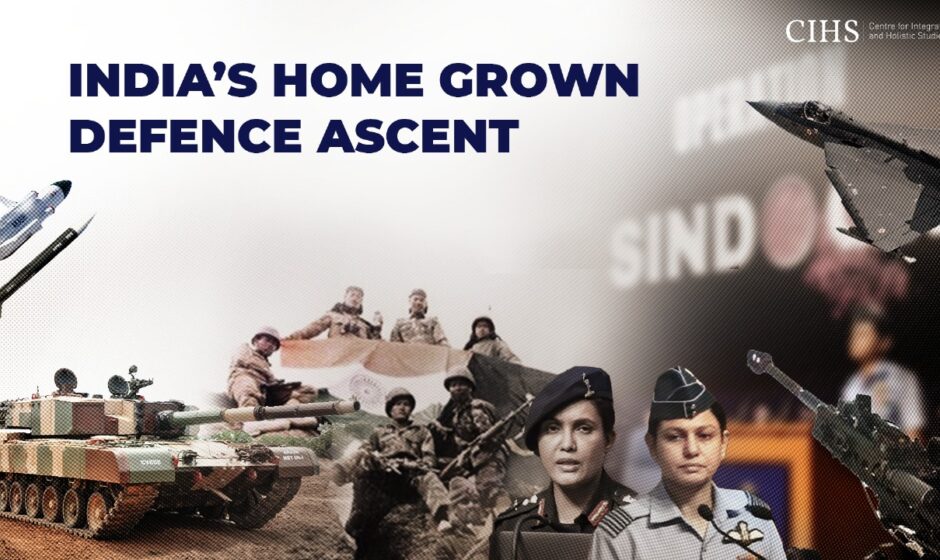From Kargil war to Operation Sindoor, Indian forces have undergone transformational changes in capabilities, capacities & outlook.
Brig Brijesh Pandey
Twenty-six years ago, in May 1999, just as global accolades for Lahore Declaration echoed, Pakistani forces crossed Line of Control (LoC) in Kargil sector of Jammu and Kashmir, masked as “freedom fighters.”

By occupying winter-vacated heights of Dras, Kaksar, Batalik, and Mushkoh, Pakistan’s Northern Light Infantry flagrantly violated international norms, bilateral accords and established military conventions.
This covert infiltration was aimed at enlarging the arc of terrorism and reigniting global attention on Kashmir through deceitful aggression.
India responded with Operation VIJAY under self-imposed constraints that precluded crossing Line of Control or deploying air power in Pakistani airspace.
These limitations notwithstanding, Indian Armed Forces reclaimed the heights after a gruelling 54-day campaign suffering 527 fatalities and 1,363 injuries.
Kargil conflict exposed glaring weaknesses in India’s military preparedness, particularly in surveillance, logistics, indigenous weapons systems and joint command structures.
The post-war Kargil Review Committee catalysed vital structural reforms and laid groundwork for a transformation that would take shape over next two decades.
Catalyst for Defence Modernisation
Lessons of Kargil underscored that bravery alone did not compensate for systemic gaps. The government responded with sweeping institutional and strategic changes:
- Intelligence and Surveillance: Creation of Defence Intelligence Agency and National Technical Research Organisation (NTRO) addressed major gaps in threat detection and real-time intelligence.
- Over dependence on Imports: Critical systems like Bofors howitzers and MiG aircraft were imported. Even essential items like winter gear were sourced externally, often at inflated costs.
- Lack of Jointness: The war revealed lack of synergy between Army, Navy and Air Force. This drove the later push for Integrated Theatre Commands and a unified command structure.
Despite initial inertia and bureaucratic roadblocks, the foundations laid after Kargil began to take effect post 2014, when the government designed a vision for New India and exhibited the political will for a full-fledged indigenous defence ecosystem.
Structural and Policy-Level Overhauls
- Make in India (2014): Aligned with Atma nirbharta (self-reliance) goal, this initiative encouraged domestic production and gradually reduced reliance on imports.
- Defence Acquisition Procedure (DAP 2020): Revised to streamline procurement, prioritize Indian vendors and fast-track capability induction.
- Chief of Defence Staff & Department of Military Affairs: Instituted to ensure synergy among three services and bridge the gap between military planning and civilian leadership.
- Ordnance Factory Reforms: The corporatisation of the OFB led to the emergence of autonomous, competitive public-sector defence companies.
R&D and Innovation Ecosystem
India has taken commendable step by establishing Anusandhan National Research Foundation with a proposed ₹ 1 Lakh Crore Research & Innovation Fund and steps such as:
- Revamped DRDO: Once plagued by delays, DRDO emerged as a strategic pillar delivering missile defence systems, radar platforms, and electronic warfare capabilities.
- Defence Startups and MSMEs: Over 400 startups are now developing AI, robotics, loitering munitions, secure communications, and advanced avionics.
- Private Sector Synergy: Major corporations like Tata, L&T, Bharat Forge, and Adani have reshaped India’s defence landscape, working in tandem with IITs, IIITs, and ISRO.
Indigenous Force Multipliers
India’s self-reliant defence strategy is exemplified by an expanding portfolio of homegrown systems:
- Tejas LCA: A fourth-generation fighter aircraft gaining export traction.
- Arjun Mk1A: Advanced main battle tank for desert warfare.
- Missile Systems: Astra, Akash, and Pinaka enhance precision strike and area denial.
- INS Vikrant: India’s first indigenously built aircraft carrier.
- Rotary Wing Platforms: ALH Dhruv and LCH Prachanda extend reach across terrains.
- Artillery Platforms: Dhanush and ATAGS redefine long-range fire support.
- Smart Munitions and Hypersonics: Enhance accuracy and survivability.
- SLBMs & Anti-Radiation Missiles: K-15, K-4, and Rudram-1 strengthen deterrence.
- Satellites: GSAT-7 and RISAT bolster battlefield awareness.
- Drones & UAVs: TAPAS-BH (Rustom II) for surveillance and strikes.
- Cyber & EW Systems: Shakti EW suite and indigenous cyber frameworks secure the digital front.
Operation Sindoor: A Defining Moment in Indigenous Warfare
On 07 May 2025, following a terror attack in Pahalgam, India launched Operation Sindoor a precision, tech-enabled retaliation that lasted just 22 minutes but left a lasting impact. Unlike the fragmented Kargil campaign, this was a demonstration of a fully integrated and indigenous warfighting ecosystem:
- Autonomous Systems: Swarm drones like Nagastra-2, ALFA-S, and Warhawk executed pinpoint strikes with zero human risk.
- Networked Command: Satellite-linked C4ISR systems by BEL enabled real-time decision-making and multi-domain coordination.
- Air Defence Superiority: Akashteer, India’s indigenous air defence network, integrated with Akash missiles to neutralise aerial threats, including UAVs.
- Fire Power : Multiple gun systems such as ATAGS and Dhanush delivered high-precision fire in high-altitude environments, redefining kinetic supremacy.
- Hypersonic Edge: Glide vehicles and GPS-independent smart munitions shattered enemy logistics and command centres.
- Logistics Mastery: Satellite-supported UAV resupply chains and all-terrain vehicles ensured sustained mobility.
- Digital Warfare: Indigenous EW systems jammed enemy radars and communication, granting spectrum dominance.
A comparative snapshot of capabilities of Indian Armed Forces during Kargil vis-à-vis Operation Sindoor can be summed up as:
| Category | Kargil (1999) | Operation Sindoor (2025) |
| Surveillance | Foreign satellites | Indigenous ISR networks, drones |
| Artillery | Swedish Bofors | ATAGS, Dhanush, Vajra K9 |
| Air Power | Mirage 2000, MiG-21 | Tejas Mk1A, drones, PGMs |
| Intelligence | Fragmented | Real-time networked |
| Cyber & EW | Minimal | Advanced indigenous capabilities |
| Import Dependency | 70%+ | Majority of systems Indian-made |
Strategic Implications
India’s growing strength in indigenous defence production carries significant strategic implications. It positions the country as a credible two-front deterrent, prepared to respond to potential threats along both its western and northern borders. Regionally, India is emerging as a power capable of projecting military influence from the Andaman Sea to the African coastline.
On the global stage, India is carving out a role as a defence exporter, expanding its presence across Southeast Asia, Africa, and Latin America. Furthermore, it is asserting itself as a leader of the Global South by presenting a scalable, technology-driven model of self-reliance that other developing nations may aspire to emulate.
Persistent Challenges
Despite India’s impressive strides in indigenous defence capability, several structural and operational challenges persist. Bureaucratic inertia continues to impede the pace of procurement, often causing critical delays in the acquisition of essential equipment.
In the realm of research and development, with stagnant R&D at 0.3% of GDP and Gross Expenditure on R&D (GERD) at 0.64% as against 2.64% of GERD of China Israel’s 5.6% R&D-to-GDP ratio supported by dense web of university-industry linkages, military R&D, and start up ecosystem.
Innovation is not a by-product of industrial growth, it is pre-condition and modest levels of R&D funding levels limit the scope and speed of innovation. Additionally, India’s defence testing infrastructure has yet to scale proportionally with the growing production capacity, creating bottlenecks in quality assurance and deployment timelines.
On the export front, while Indian defence products are gaining international attention, there is a pressing need for stronger global marketing mechanisms and streamlined certification processes to effectively compete in international markets.
Dawn of Strategic Sovereignty
From frozen heights of Kargil to precision battlefields of Operation Sindoor, India has undergone profound military metamorphosis. This evolution reflects not just technological innovation, but a strategic vision rooted in resilience, sovereignty, and civil-military synergy. As India approaches its centenary of independence in 2047, the foundation laid by these two watershed moments will continue to shape its trajectory as a confident, capable, and autonomous power in the global order.
(Author is a defence analyst, former military advisor and commanded an artillery brigade)



